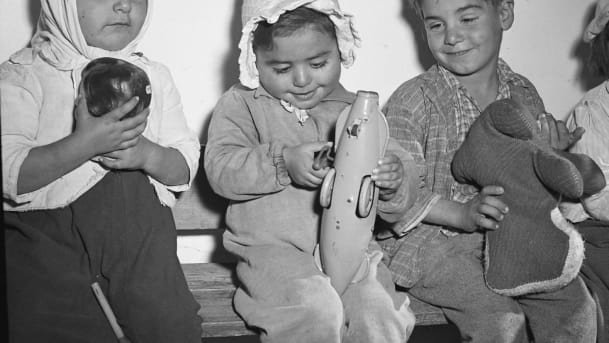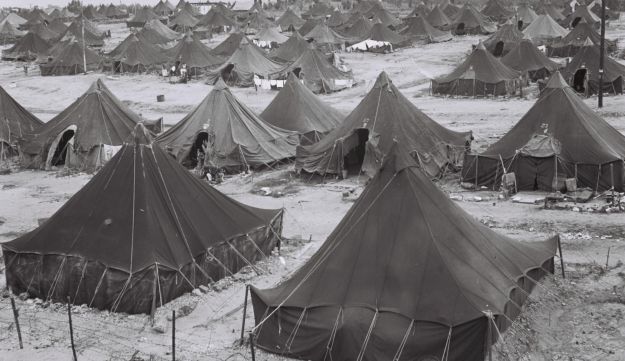Why Have Transit Camps for Mizrahi Jews Been Written Out of Israeli History?
In 1951, a quarter of a million people were living in what was known as ma’abarot, 80 percent of them from Islamic lands. Most of the camps were dismantled by 1959. Ten forgotten years.

An odd question is posed by the protagonist of the television series “Zagouri Empire,” in the first episode of the new season. Why, he asks, does the Israeli calendar have no “Ma’abarot Day” – a reference to the 1950s’ transit camps that mainly housed Jewish refugees from the Middle East and North Africa.
You won’t find an entry for ma’abarot in the Encyclopedia Hebraica. The 1978 edition contains a terse discussion of the subject (27 lines), but not as a separate entry, rather in the general volume devoted to the Land of Israel.
Nor do we have a “Museum of Ma’abarot.” We have an Israel Air Force museum and a Yitzhak Rabin museum and a Palmach museum and a Ya’ir Stern museum (commemorating the founder of the pre-state underground organization Lehi). But to learn about transit camps, you’ll have to poke around in archives or listen to old wives’ tales.
In a collection of Davar Le’Yeladim – the weekly children’s magazine published by the (now-defunct) Hebrew daily Davar, which was a mouthpiece for the ruling establishment – from 1951-1952, I found barely 15 articles on the subject, most of them written by young readers themselves.

Who is responsible for constructing our history? Who is charged with the role of filling with content that odd and self-interested concept referred to as “collective memory”?
When it comes to subjects like transit camps and poverty, this is not only a question for learned historians. Recent surveys have provided painful findings about the number of poor children in Israel. A heated debate has also arisen about who’s responsible for the fact that housing prices have lurched out of control – Benjamin Netanyahu or Ehud Barak, or maybe it was the other Ehud (Olmert), or possibly Menachem Begin, Golda or Ben-Gurion?
Perhaps the question should be rephrased: Who is responsible for the fact that there are some people who have no prospect of being able to buy an apartment today, whereas others own entire buildings? That’s a question that calls for a consideration of the history of poverty in this country.
The history of poverty here is a huge blank. Our great cultural repression. The ma’abarot, the product of Israeli poverty, are a historical wound that’s been removed from the map. And not by chance.
In 1951, a quarter of a million people were living in ma’abarot, 80 percent of them from Islamic lands. Most of the camps were dismantled by 1959. Ten forgotten years. Memories erased.
Here, in a nutshell, are a few important points which are apparently inconvenient to recall. The first inhabitants of the ma’abarot lived in tents, one per family. Afterward, an improved tent, hut-shaped but still made of canvas, came on the scene. Later, there were tin huts and wooden shacks. Some of the ma’abarot weren’t hooked up to the water or power supply, and filthy public toilets often served dozens of people.
In April 1949, Zalman Aranne, a leading member of the Mapai ruling party (and later minister of education), warned that a “catastrophic situation” existed in the camps. Elihayu Dobkin, a senior figure in the Jewish Agency, described the conditions as a “holy horror.” But David Ben-Gurion ruled that the improved dwellings that were being demanded for the new immigrants were too costly: “I don’t accept this pampering with respect to people not living in tents. We are spoiling them. People can live for years in tents. Anyone who doesn’t want to live in them needn’t bother coming here.”
Beginning in September 1949, the Jews of Poland were allowed to immigrate to the nascent Jewish state. Toward the end of that year, the Agency reached the conclusion that the new arrivals from Poland deserved better absorption conditions than the immigrants who preceded them. “There are respected individuals among them,” was its explanation.
To spare these newcomers the suffering of the transit camps, it was proposed to house them in hotels. At the same time, meetings were held among the authorities about speeding up the Poles’ placement in permanent housing – including in apartments originally allocated for immigrants from the Arab countries.
“They were all aware that giving preference to the Polish immigrants was wrong and so they resolved to keep it secret,” wrote historian Tom Segev in his book “1949: The First Israelis.”
In January 1953, the Agency’s Immigrant Absorption Department in Jerusalem noted, “Most of the European families have long since left the ma’abarot, and more than 90 percent of the camps’ inhabitants are from the Oriental communities.”
Shattered images
During the past month I’ve been visiting distressed areas in Israel – the winter 2015 version. Every morning I arrive in a different place. Kfar Shalem, Ofakim, Or Yehuda, Ramle, the long and depressing tenements of Jaffa Dalet. Distressed neighborhoods of Israeli Jews. Happily, I haven’t seen especially harsh sights. The images I had in my mind of the ma’abarot and other sorts of immigrant camps have been shattered. At the end of the 1970s, Project Renewal was launched to rehabilitate rundown neighborhoods, and outwardly the situation has over the years become fairly reasonable. But many of the people I’m meeting are unemployed; a great many lead hardscrabble lives.
It seems to me that before we talk about the distress of the retail price of Milky, the chocolate pudding snack that symbolizes the middle class, we should recall this country’s distressed neighborhoods. They are generally mute sites. They have generated a few outbursts in the past, such as the “Wadi Salib riots” in Haifa in 1959, and the Israeli Black Panthers protest movement in the 1970s. Lately we’ve heard about Givat Amal and Kfar Shalem. But generally, poverty here is mute.
Back to the Encyclopedia Hebraica. In large measure, the encyclopedia was responsible for constructing the canonical Israeli consciousness. A perusal of it shows that the fact that it was a Hebrew encyclopedia and that its authors were stuck in the Levant, did not prompt them to search under their very own, local streetlights.
For example, the entry “Karl” (the name of kings and emperors from the House of Habsburg and from Luxembourg) received two full pages. People named Rabinovich (or a variant spelling in English) were also given two pages. Krotoszyn, a town of 22,000 people in Poland with a highly developed Jewish community – got 25 lines. Kiryat Malakhi, with 12,000 inhabitants at the time, got 13 lines. But who’s counting?
And maybe it’s not by chance that when you Google “ma’abarot” in Hebrew, the first entry that comes up is Kibbutz Ma’abarot.
Prof. Dalia Gavriely-Nuri teaches in the politics and communications department of Hadassah Academic College, Jerusalem, and is a research fellow at the Hebrew University’s Truman Institute for the Advancement of Peace.
originally published Apr 18, 2015 4:02 PM
Category: Israel, Social Issues



